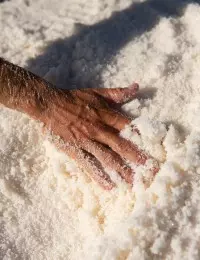
What is natural salt and how do you recognize it?
At home, at the restaurant table or in the aisle, it's not uncommon to come across different salts with very different origins, uses, properties and benefits. Origin is one of the main differentiating criteria, and here we distinguish two types of salt: natural salt, a product of the sea, sun and wind, and a less natural salt, refined salt.
What is natural salt?
Definition of natural salt
Natural salt is unrefined salt: it has not undergone any chemical treatment. It's a salt extracted directly from nature and naturally gray that has retained all its natural benefits and properties. It is mainly used for cooking, but also for health care.
Origin, provenance and harvesting technique of natural salt
Natural salt is extracted from seawater or underground mines resulting from sedimentation and is produced naturally in many regions around the world. Its region of origin defines its appearance (color...) and its many gustatory qualities.
Sea salt, the natural salt par excellence, is produced by evaporation of salt water from the sea in the harvesting basins of salt marshes.
From the ocean to the final harvest, the sea water will follow the path of the saltworks:
- The sea water will travel inland via the étiers, long canals making the link between the ocean and the saltworks.
- Then, at the time of high tides and when he needs water, the salt worker will let seawater enter his vasière, which will serve as a reserve between two tides but also as a settling basin.A gentle slope then takes this water to the evaporation basins, ending up in the œillets, where the salt is harvested.
- Finally, it's in the œillets, at the center of the saltworks, that the seawater reaches a sufficient concentration for the salt it contains to crystallize. The salt worker can then manage the amount of water in the carnations to compensate for evaporation and ensure a unique salt quality.
Once the carnations are filled with water, the salt worker will wait for warm, slightly windy summer days to harvest his salt from them. He will delicately pick the Fleur de sel from the surface of the water and push the coarse salt deposited on the clay at the bottom of the carnations.
The salt worker's trade
The salt worker works exclusively by hand using traditional tools, following ancestral methods and without the addition of any chemicals. This artisanal production technique enables both the production of quality salt and the preservation of a unique and exceptional site and know-how.
Since 1979, a 12-month training course in the profession of salt worker with an internship master has been set up by the Loire-Atlantique Chamber of Agriculture to train young enthusiasts in salt farming and to renew and perpetuate this profession with precious and ancestral values.
Recognizing natural salt
What is refined salt
Unlike natural salt, refined salt is chemically treated to purify it, whiten it and enable it to be preserved better. Its chemical treatment has removed most of its minerals, and it contains almost exclusively sodium chloride. Refined salts are also enriched with iodine and are mainly used in the chemical and food industries to produce processed foods.
____________
Le sel de Guérande le Guérandais is a natural, unrefined, unwashed sea salt. It is harvested by hand from salt marshes using an ancestral technique by salt workers.
____________
Differences between natural and refined salt
Generally, refined salt is used for cooking because of its ease of storage, shelf life and mild, uniform taste. It can be recognized by its pristine white color obtained after refining and drying, operations during which iodine is added and most of its natural minerals such as magnesium, potassium and calcium are removed.
Natural salts, which are better for the health, possess all their natural nutritional qualities and are also used for cooking (particularly sea salt, which is tastier than salt extracted from sedimentation) and health care. However, it should always be consumed in reasonable quantities.

Le Guérandais natural salt production
Le Guérandais Guérande Salt is a natural salt from the Atlantic Ocean, produced on the Guérande salt marshes, an intense and authentic territory in which the culture of salt has been engraved for millennia.
The Guérande salt marshes and the Le Guérandais cooperative welcome 225 cooperative members' salt workers every day, working to produce natural (non-iodized) salt in their saltworks.
Le Guérandais salts
Le Guérandais Guérande salts are natural sea salts, untreated, unbleached and produced in an environmentally friendly way.
Fleur de sel: Fleur de sel, the true white gold of the marshes, is harvested by hand from the surface of the water by salt workers using a unique know-how. It's a fine, elegant product, much appreciated by chefs for its subtle taste and light crunch.
Coarse salt: coarse salt, naturally gray from the clay at the bottom of carnations, is unwashed and ideal for cooking all kinds of recipes, for cooking in a salt crust, broths and grilled meats to which it gives great flavor and crunch. It settles to the bottom of carnations after evaporation and is harvested by hand by salt workers.
Milled Sea Salt: ground salt is obtained by drying and grinding coarse salt. Unrefined and non-iodized, it preserves the pleasure, benefits and all the authentic flavors of salt.




